Impervious Surface Area Patterns and Their Response to Land Surface Temperature Mechanism in Urban–Rural Regions of Qingdao, China
Abstract
:1. Introduction
2. Materials and Methods
2.1. Study Area
2.2. Flowchart of This Study
2.3. Production of Land-Use Data in 2020 and Extraction of Urban–Rural Boundaries from 1970 to 2020
2.3.1. Land Use Data Acquisition
2.3.2. Land Classification System Description of Urban and Rural Areas
2.3.3. Remote Sensing Image Download and Data Preprocessing
2.3.4. Digital Visualization and Acquisition of Urban–Rural Dynamic Land
2.4. Establishment of the Impervious Surface Area Component in Urban–Rural Regions
2.4.1. Preprocessing of Remote Sensing Images and Obtaining the end Elements of Different Land Types
2.4.2. Fully Constrained Least Squares Mixed Pixel Decomposition Model
2.4.3. Obtaining the Impervious Surface Area Component in Urban and Rural Regions
2.5. Land Surface Temperature Retrieval and Calculation of Corresponding Energy Mechanisms
3. Results
3.1. Analysis of Spatiotemporal Characteristics and Regional Differences in Urban and Rural Land Use from 1970 to 2020
3.1.1. Analysis of the Quantity and Spatial Change Characteristics of Urban and Rural Regions
3.1.2. Analysis of the Differences in Urban–Rural Land Use in Different Administrative Districts
3.2. Analysis of the Spatiotemporal Pattern of Urban–Rural Impervious Surface Area
3.3. Analysis of the Response Characteristics of Urban–Rural Impervious Surface Area to Land Surface Temperature
3.3.1. Analysis of Land Surface Temperature in the Whole Region and in Different Administrative Regions
3.3.2. Comparison of the Differences in Land Surface Temperature between Urban and Rural Regions
3.3.3. Response Characteristics of Urban and Rural Land Surface Temperature to Impervious Surface Area
3.4. Mechanism Analysis of LST Response to ISA Changes in Urban and Rural Regions
4. Discussion
4.1. The Horizontal Gradient Effect and Vertical Density Effect of Land Surface Temperature on Impervious Surface Area in Urban and Rural Regions of Central Coastal Region of China
4.2. Differences in Characteristic Patterns of Urban Impervious Surface Areas in Different Regions and Potential Eco-Environmental Effects
4.3. Rural Settlements in China Experienced Drastic Structural Evolution
4.4. Shortcomings and Prospects of Research
5. Conclusions
Author Contributions
Funding
Data Availability Statement
Conflicts of Interest
References
- Li, Y.; Kong, X.; Zhu, Z. Multiscale analysis of the correlation patterns between the urban population and construction land in China. Sustain. Cities Soc. 2020, 61, 102326. [Google Scholar] [CrossRef]
- Li, Y. Urban–rural interaction patterns and dynamic land use: Implications for urban–rural integration in China. Reg. Environ. Chang. 2012, 12, 803–812. [Google Scholar] [CrossRef]
- Guan, X.; Wei, H.; Lu, S.; Dai, Q.; Su, H. Assessment on the urbanization strategy in China: Achievements, challenges and reflections. Habitat Int. 2018, 71, 97–109. [Google Scholar] [CrossRef]
- Kuang, W.; Liu, J.; Dong, J.; Chi, W.; Zhang, C. The rapid and massive urban and industrial land expansions in China between 1990 and 2010: A CLUD-based analysis of their trajectories, patterns, and drivers. Landsc. Urban Plan. 2016, 145, 21–33. [Google Scholar] [CrossRef]
- Gaughan, A.E.; Stevens, F.R.; Huang, Z.; Nieves, J.J.; Sorichetta, A.; Lai, S.; Ye, X.; Linard, C.; Hornby, G.M.; Hay, S.I. Spatiotemporal patterns of population in mainland China, 1990 to 2010. Sci. Data 2016, 3, 160005. [Google Scholar] [CrossRef] [PubMed]
- Wang, X.; Shi, R.; Zhou, Y. Dynamics of urban sprawl and sustainable development in China. Socio-Econ. Plan. Sci. 2020, 70, 100736. [Google Scholar] [CrossRef]
- Kuang, W.; Zhang, S.; Li, X.; Lu, D. A 30 m resolution dataset of China’s urban impervious surface area and green space, 2000–2018. Earth Syst. Sci. Data 2021, 13, 63–82. [Google Scholar] [CrossRef]
- Wu, W.; Li, C.; Liu, M.; Hu, Y.; Xiu, C. Change of impervious surface area and its impacts on urban landscape: An example of Shenyang between 2010 and 2017. Ecosyst. Health Sustain. 2020, 6, 1767511. [Google Scholar] [CrossRef]
- Sekertekin, A.; Zadbagher, E. Simulation of future land surface temperature distribution and evaluating surface urban heat island based on impervious surface area. Ecol. Indic. 2021, 122, 107230. [Google Scholar] [CrossRef]
- Morabito, M.; Crisci, A.; Guerri, G.; Messeri, A.; Congedo, L.; Munafò, M. Surface urban heat islands in Italian metropolitan cities: Tree cover and impervious surface influences. Sci. Total Environ. 2021, 751, 142334. [Google Scholar] [CrossRef]
- Luo, Y.; Zhao, Y.; Yang, K.; Chen, K.; Pan, M.; Zhou, X. Dianchi Lake watershed impervious surface area dynamics and their impact on lake water quality from 1988 to 2017. Environ. Sci. Pollut. Res. 2018, 25, 29643–29653. [Google Scholar] [CrossRef] [PubMed]
- Yang, K.; Pan, M.; Luo, Y.; Chen, K.; Zhao, Y.; Zhou, X. A time-series analysis of urbanization-induced impervious surface area extent in the Dianchi Lake watershed from 1988–2017. Int. J. Remote Sens. 2019, 40, 573–592. [Google Scholar] [CrossRef]
- McGlynn, T.P.; Meineke, E.K.; Bahlai, C.A.; Li, E.; Hartop, E.A.; Adams, B.J.; Brown, B.V. Temperature accounts for the biodiversity of a hyperdiverse group of insects in urban Los Angeles. Proc. R. Soc. B 2019, 286, 20191818. [Google Scholar] [CrossRef] [PubMed]
- Yang, Q.; Huang, X.; Yang, J.; Liu, Y. The relationship between land surface temperature and artificial impervious surface fraction in 682 global cities: Spatiotemporal variations and drivers. Environ. Res. Lett. 2021, 16, 024032. [Google Scholar] [CrossRef]
- Zhang, Y.; Sun, L. Spatial-temporal impacts of urban land use land cover on land surface temperature: Case studies of two Canadian urban areas. Int. J. Appl. Earth Obs. Geoinf. 2019, 75, 171–181. [Google Scholar] [CrossRef]
- Yang, J.; Jin, S.; Xiao, X.; Jin, C.; Xia, J.C.; Li, X.; Wang, S. Local climate zone ventilation and urban land surface temperatures: Towards a performance-based and wind-sensitive planning proposal in megacities. Sustain. Cities Soc. 2019, 47, 101487. [Google Scholar] [CrossRef]
- Vancutsem, C.; Ceccato, P.; Dinku, T.; Connor, S.J. Evaluation of MODIS land surface temperature data to estimate air temperature in different ecosystems over Africa. Remote Sens. Environ. 2010, 114, 449–465. [Google Scholar] [CrossRef]
- Guo, A.; Yang, J.; Sun, W.; Xiao, X.; Cecilia, J.X.; Jin, C.; Li, X. Impact of urban morphology and landscape characteristics on spatiotemporal heterogeneity of land surface temperature. Sustain. Cities Soc. 2020, 63, 102443. [Google Scholar] [CrossRef]
- Yang, J.; Zhan, Y.; Xiao, X.; Xia, J.C.; Sun, W.; Li, X. Investigating the diversity of land surface temperature characteristics in different scale cities based on local climate zones. Urban Clim. 2020, 34, 100700. [Google Scholar] [CrossRef]
- Estoque, R.C.; Murayama, Y.; Myint, S.W. Effects of landscape composition and pattern on land surface temperature: An urban heat island study in the megacities of Southeast Asia. Sci. Total Environ. 2017, 577, 349–359. [Google Scholar] [CrossRef]
- Zhao, Z.; Sharifi, A.; Dong, X.; Shen, L.; He, B.-J. Spatial variability and temporal heterogeneity of surface urban heat island patterns and the suitability of local climate zones for land surface temperature characterization. Remote Sens. 2021, 13, 4338. [Google Scholar] [CrossRef]
- Liu, X.; Zhou, Y.; Yue, W.; Li, X.; Liu, Y.; Lu, D. Spatiotemporal patterns of summer urban heat island in Beijing, China using an improved land surface temperature. J. Clean. Prod. 2020, 257, 120529. [Google Scholar] [CrossRef]
- Ren, T.; Zhou, W.; Wang, J. Beyond intensity of urban heat island effect: A continental scale analysis on land surface temperature in major Chinese cities. Sci. Total Environ. 2021, 791, 148334. [Google Scholar] [CrossRef] [PubMed]
- Huang, F.; Yu, Y.; Feng, T. Automatic extraction of impervious surfaces from high resolution remote sensing images based on deep learning. J. Vis. Commun. Image Represent. 2019, 58, 453–461. [Google Scholar] [CrossRef]
- Wang, Y.; Li, M. Urban impervious surface detection from remote sensing images: A review of the methods and challenges. Ieee Geosci. Remote Sens. Mag. 2019, 7, 64–93. [Google Scholar] [CrossRef]
- Zhao, J.; Tsutsumida, N. Mapping Fragmented Impervious Surface Areas Overlooked by Global Land-Cover Products in the Liping County, Guizhou Province, China. Remote Sens. 2020, 12, 1527. [Google Scholar] [CrossRef]
- Tang, Y.; Shao, Z.; Huang, X.; Cai, B. Mapping impervious surface areas using time-series nighttime light and MODIS imagery. Remote Sens. 2021, 13, 1900. [Google Scholar] [CrossRef]
- Phinn, S.; Stanford, M.; Scarth, P.; Murray, A.; Shyy, P. Monitoring the composition of urban environments based on the vegetation-impervious surface-soil (VIS) model by subpixel analysis techniques. Int. J. Remote Sens. 2002, 23, 4131–4153. [Google Scholar] [CrossRef]
- Ridd, M.K. Exploring a VIS (vegetation-impervious surface-soil) model for urban ecosystem analysis through remote sensing: Comparative anatomy for cities. Int. J. Remote Sens. 1995, 16, 2165–2185. [Google Scholar] [CrossRef]
- Yue, W. Improvement of urban impervious surface estimation in Shanghai using Landsat7 ETM+ data. Chin. Geogr. Sci. 2009, 19, 283–290. [Google Scholar] [CrossRef]
- Wang, J.; Wu, Z.; Wu, C.; Cao, Z.; Fan, W.; Tarolli, P. Improving impervious surface estimation: An integrated method of classification and regression trees (CART) and linear spectral mixture analysis (LSMA) based on error analysis. Gisci. Remote Sens. 2018, 55, 583–603. [Google Scholar] [CrossRef]
- Cristóbal, J.; Jiménez-Muñoz, J.C.; Prakash, A.; Mattar, C.; Skoković, D.; Sobrino, J.A. An improved single-channel method to retrieve land surface temperature from the Landsat-8 thermal band. Remote Sens. 2018, 10, 431. [Google Scholar] [CrossRef]
- Sahana, M.; Ahmed, R.; Sajjad, H. Analyzing land surface temperature distribution in response to land use/land cover change using split window algorithm and spectral radiance model in Sundarban Biosphere Reserve, India. Model. Earth Syst. Environ. 2016, 2, 81. [Google Scholar] [CrossRef]
- Du, C.; Ren, H.; Qin, Q.; Meng, J.; Zhao, S. A practical split-window algorithm for estimating land surface temperature from Landsat 8 data. Remote Sens. 2015, 7, 647–665. [Google Scholar] [CrossRef]
- Liu, K.; Su, H.; Li, X. Comparative assessment of two vegetation fractional cover estimating methods and their impacts on modeling urban latent heat flux using Landsat imagery. Remote Sens. 2017, 9, 455. [Google Scholar] [CrossRef]
- Liu, J.; Kuang, W.; Zhang, Z.; Xu, X.; Qin, Y.; Ning, J.; Zhou, W.; Zhang, S.; Li, R.; Yan, C. Spatiotemporal characteristics, patterns, and causes of land-use changes in China since the late 1980s. J. Geogr. Sci. 2014, 24, 195–210. [Google Scholar] [CrossRef]
- Zhang, Z.; Wang, X.; Zhao, X.; Liu, B.; Yi, L.; Zuo, L.; Wen, Q.; Liu, F.; Xu, J.; Hu, S. A 2010 update of National Land Use/Cover Database of China at 1: 100000 scale using medium spatial resolution satellite images. Remote Sens. Environ. 2014, 149, 142–154. [Google Scholar] [CrossRef]
- Xu, Y.; Yu, L.; Peng, D.; Zhao, J.; Cheng, Y.; Liu, X.; Li, W.; Meng, R.; Xu, X.; Gong, P. Annual 30-m land use/land cover maps of China for 1980–2015 from the integration of AVHRR, MODIS and Landsat data using the BFAST algorithm. Sci. China Earth Sci. 2020, 63, 1390–1407. [Google Scholar] [CrossRef]
- Liu, Y.; Zhong, Y.; Ma, A.; Zhao, J.; Zhang, L. Cross-resolution national-scale land-cover mapping based on noisy label learning: A case study of China. Int. J. Appl. Earth Obs. Geoinf. 2023, 118, 103265. [Google Scholar] [CrossRef]
- Ning, J.; Liu, J.; Kuang, W.; Xu, X.; Zhang, S.; Yan, C.; Li, R.; Wu, S.; Hu, Y.; Du, G. Spatiotemporal patterns and characteristics of land-use change in China during 2010–2015. J. Geogr. Sci. 2018, 28, 547–562. [Google Scholar] [CrossRef]
- Heylen, R.; Burazerovic, D.; Scheunders, P. Fully constrained least squares spectral unmixing by simplex projection. IEEE Trans. Geosci. Remote Sens. 2011, 49, 4112–4122. [Google Scholar] [CrossRef]
- Yin, C.; Meng, F.; Yu, Q. Calculation of land surface emissivity and retrieval of land surface temperature based on a spectral mixing model. Infrared Phys. Technol. 2020, 108, 103333. [Google Scholar] [CrossRef]
- Rozenstein, O.; Qin, Z.; Derimian, Y.; Karnieli, A. Derivation of land surface temperature for Landsat-8 TIRS using a split window algorithm. Sensors 2014, 14, 5768–5780. [Google Scholar] [CrossRef] [PubMed]
- Liu, K.; Su, H.; Wang, W.; Yang, L.; Liang, H.; Li, X. Comparative assessment of Two Source of Landsat TM vegetative fraction coverage for modeling urban latent heat fluxes. In Proceedings of the 2016 IEEE International Geoscience and Remote Sensing Symposium (IGARSS), Beijing, China, 10–15 July 2016; pp. 6762–6765. [Google Scholar]
- Zhang, T.; Xiao, Y.; Liang, D.; Tang, H.; Xu, J.; Yuan, S.; Luan, B. A physically-based model for dissolved pollutant transport over impervious surfaces. J. Hydrol. 2020, 590, 125478. [Google Scholar] [CrossRef]
- Pan, T.; Kuang, W.; Pan, R.; Niu, Z.; Dou, Y. Hierarchical Urban Land Mappings and Their Distribution with Physical Medium Environments Using Time Series of Land Resource Images in Beijing, China (1981–2021). Remote Sens. 2022, 14, 580. [Google Scholar] [CrossRef]
- Peng, J.; Liu, Y.; Ma, J.; Zhao, S. A new approach for urban–rural fringe identification: Integrating impervious surface area and spatial continuous wavelet transform. Landsc. Urban Plan. 2018, 175, 72–79. [Google Scholar] [CrossRef]
- Mathew, A.; Khandelwal, S.; Kaul, N. Spatial and temporal variations of urban heat island effect and the effect of percentage impervious surface area and elevation on land surface temperature: Study of Chandigarh city, India. Sustain. Cities Soc. 2016, 26, 264–277. [Google Scholar] [CrossRef]
- Pan, T.; Kuang, W.; Hamdi, R.; Zhang, C.; Zhang, S.; Li, Z.; Chen, X. City-level comparison of urban land-cover configurations from 2000–2015 across 65 countries within the Global Belt and Road. Remote Sens. 2019, 11, 1515. [Google Scholar] [CrossRef]
- Meng, H.; Jing, L.; Xin, H. The influence of underlying surface on land surface temperature--a case study of urban green space in Harbin. Energy Procedia 2019, 157, 746–751. [Google Scholar] [CrossRef]
- Li, M.; Zang, S.; Wu, C.; Na, X. Spatial and temporal variation of the urban impervious surface and its driving forces in the central city of Harbin. J. Geogr. Sci. 2018, 28, 323–336. [Google Scholar] [CrossRef]
- Liu, G.; Zhang, L.; He, B.; Jin, X.; Zhang, Q.; Razafindrabe, B.; You, H. Temporal changes in extreme high temperature, heat waves and relevant disasters in Nanjing metropolitan region, China. Nat. Hazards 2015, 76, 1415–1430. [Google Scholar] [CrossRef]
- Huang, X.; Li, J.; Yang, J.; Zhang, Z.; Li, D.; Liu, X. 30 m global impervious surface area dynamics and urban expansion pattern observed by Landsat satellites: From 1972 to 2019. Sci. China Earth Sci. 2021, 64, 1922–1933. [Google Scholar] [CrossRef]
- Liu, M.; Du, G.; Yu, F.; Kuang, W. Remote Sensing Monitoring and Analysis of Urban-Rural Gradient Construction Land and Impervious Surface in Harbin. Remote Sens. Technol. Appl. 2020, 35, 1206–1217. [Google Scholar]
- Li, P.; Zhang, R.; Xu, L. Three-dimensional ecological footprint based on ecosystem service value and their drivers: A case study of Urumqi. Ecol. Indic. 2021, 131, 108117. [Google Scholar] [CrossRef]
- Pan, T.; Lu, D.; Zhang, C.; Chen, X.; Shao, H.; Kuang, W.; Chi, W.; Liu, Z.; Du, G.; Cao, L. Urban land-cover dynamics in arid China based on high-resolution urban land mapping products. Remote Sens. 2017, 9, 730. [Google Scholar] [CrossRef]
- Sarkar Chaudhuri, A.; Singh, P.; Rai, S. Assessment of impervious surface growth in urban environment through remote sensing estimates. Environ. Earth Sci. 2017, 76, 541. [Google Scholar] [CrossRef]
- Hu, C.; Song, M.; Zhang, A. Dynamics of the eco-environmental quality in response to land use changes in rapidly urbanizing areas: A case study of Wuhan, China from 2000 to 2018. J. Geogr. Sci. 2023, 33, 245–265. [Google Scholar] [CrossRef]
- Shuster, W.D.; Bonta, J.; Thurston, H.; Warnemuende, E.; Smith, D. Impacts of impervious surface on watershed hydrology: A review. Urban Water J. 2005, 2, 263–275. [Google Scholar] [CrossRef]
- Arora, A.S.; Reddy, A.S. Multivariate analysis for assessing the quality of stormwater from different Urban surfaces of the Patiala city, Punjab (India). Urban Water J. 2013, 10, 422–433. [Google Scholar] [CrossRef]
- Kun, Y.; Meie, P.; Rong, Y.; Yi, S.; Chao, M. Water environmental impacts of impervious surfaces and control measures in Dianchi Lake Basin, China. Chin. J. Environ. Eng. 2016, 10, 5407–5412. [Google Scholar]
- Shi, Z.; Li, X.; Hu, T.; Yuan, B.; Yin, P.; Jiang, D. Modeling the intensity of surface urban heat island based on the impervious surface area. Urban Clim. 2023, 49, 101529. [Google Scholar] [CrossRef]
- Yuan, F.; Bauer, M.E. Comparison of impervious surface area and normalized difference vegetation index as indicators of surface urban heat island effects in Landsat imagery. Remote Sens. Environ. 2007, 106, 375–386. [Google Scholar] [CrossRef]
- Majumder, A.; Setia, R.; Kingra, P.; Sembhi, H.; Singh, S.P.; Pateriya, B. Estimation of land surface temperature using different retrieval methods for studying the spatiotemporal variations of surface urban heat and cold islands in Indian Punjab. Environ. Dev. Sustain. 2021, 23, 15921–15942. [Google Scholar] [CrossRef]
- Zhang, Y.; Balzter, H.; Li, Y. Influence of impervious surface area and fractional vegetation cover on seasonal urban surface heating/cooling rates. Remote Sens. 2021, 13, 1263. [Google Scholar] [CrossRef]
- Ahmed, G.; Zan, M.; Kasimu, A. Spatial–Temporal Changes and Influencing Factors of Surface Temperature in Urumqi City Based on Multi-Source Data. Environ. Eng. Sci. 2022, 39, 928–937. [Google Scholar] [CrossRef]
- Verburg, P.H.; van Berkel, D.B.; van Doorn, A.M.; van Eupen, M.; van den Heiligenberg, H.A. Trajectories of land use change in Europe: A model-based exploration of rural futures. Landsc. Ecol. 2010, 25, 217–232. [Google Scholar] [CrossRef]
- Liu, Y. Introduction to land use and rural sustainability in China. Land Use Policy 2018, 74, 1–4. [Google Scholar] [CrossRef]
- Gao, W.; de Vries, W.T.; Zhao, Q. Understanding rural resettlement paths under the increasing versus decreasing balance land use policy in China. Land Use Policy 2021, 103, 105325. [Google Scholar] [CrossRef]
- Ianchovichina, E.; Martin, W. Trade Liberalization in China’s Accession to the World Trade Organization; World Bank Publications: Herndon, VA, USA, 2001; Volume 2623. [Google Scholar]
- Sachs, J.D.; Woo, W.T. China’s economic growth after WTO membership. J. Chin. Econ. Bus. Stud. 2003, 1, 1–31. [Google Scholar] [CrossRef]
- Zhai, F.; Wang, Z. WTO accession, rural labour migration and urban unemployment in China. Urban Stud. 2002, 39, 2199–2217. [Google Scholar] [CrossRef]
- Liu, C.; Zhang, L.; Huang, J.; Luo, R.; Yi, H.; Shi, Y.; Rozelle, S. Project design, village governance and infrastructure quality in rural China. China Agric. Econ. Rev. 2013, 5, 248–280. [Google Scholar] [CrossRef]
- Liu, Y.; Zang, Y.; Yang, Y. China’s rural revitalization and development: Theory, technology and management. J. Geogr. Sci. 2020, 30, 1923–1942. [Google Scholar] [CrossRef]
- Zhou, Y.; Li, Y.; Xu, C. Land consolidation and rural revitalization in China: Mechanisms and paths. Land Use Policy 2020, 91, 104379. [Google Scholar] [CrossRef]
- Meng, F.; Guo, J.; Guo, Z.; Lee, J.C.; Liu, G.; Wang, N. Urban ecological transition: The practice of ecological civilization construction in China. Sci. Total Environ. 2021, 755, 142633. [Google Scholar] [CrossRef] [PubMed]
- Hansen, M.H.; Li, H.; Svarverud, R. Ecological civilization: Interpreting the Chinese past, projecting the global future. Glob. Environ. Chang. 2018, 53, 195–203. [Google Scholar] [CrossRef]
- Wang, J.; Wang, X.; Du, G.; Zhang, H. Temporal and Spatial Changes of Rural Settlements and Their Influencing Factors in Northeast China from 2000 to 2020. Land 2022, 11, 1640. [Google Scholar] [CrossRef]
- Wang, M.-Y.; Sung, H.-C.; Liu, J.-Y. Population Aging and Its Impact on Human Wellbeing in China. Front. Public Health 2022, 10, 566–582. [Google Scholar] [CrossRef] [PubMed]
- Li, J.; Lo, K.; Zhang, P.; Guo, M. Reclaiming small to fill large: A novel approach to rural residential land consolidation in China. Land Use Policy 2021, 109, 105706. [Google Scholar] [CrossRef]
- Li, Y.; Wu, W.; Liu, Y. Land consolidation for rural sustainability in China: Practical reflections and policy implications. Land Use Policy 2018, 74, 137–141. [Google Scholar] [CrossRef]

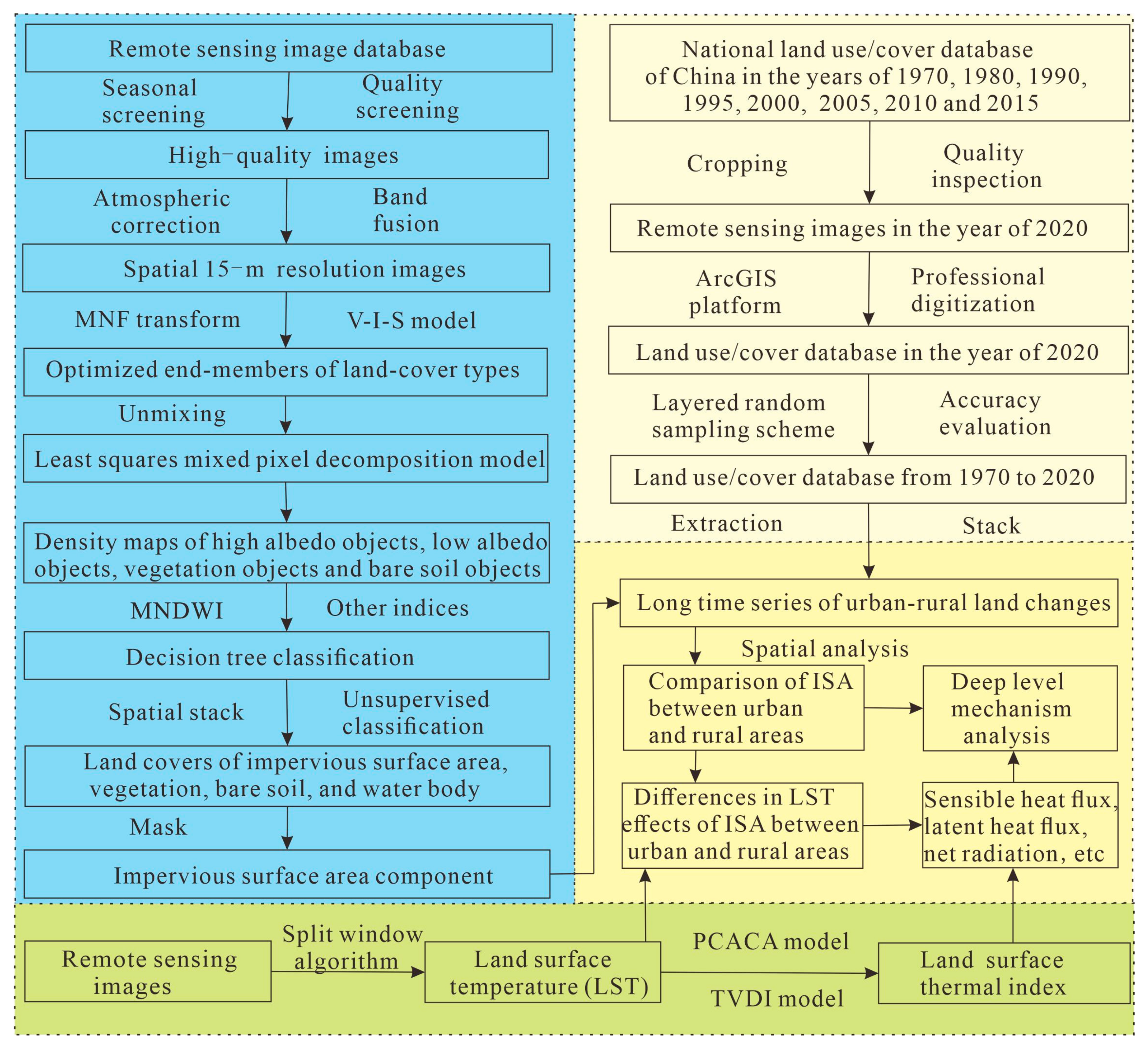
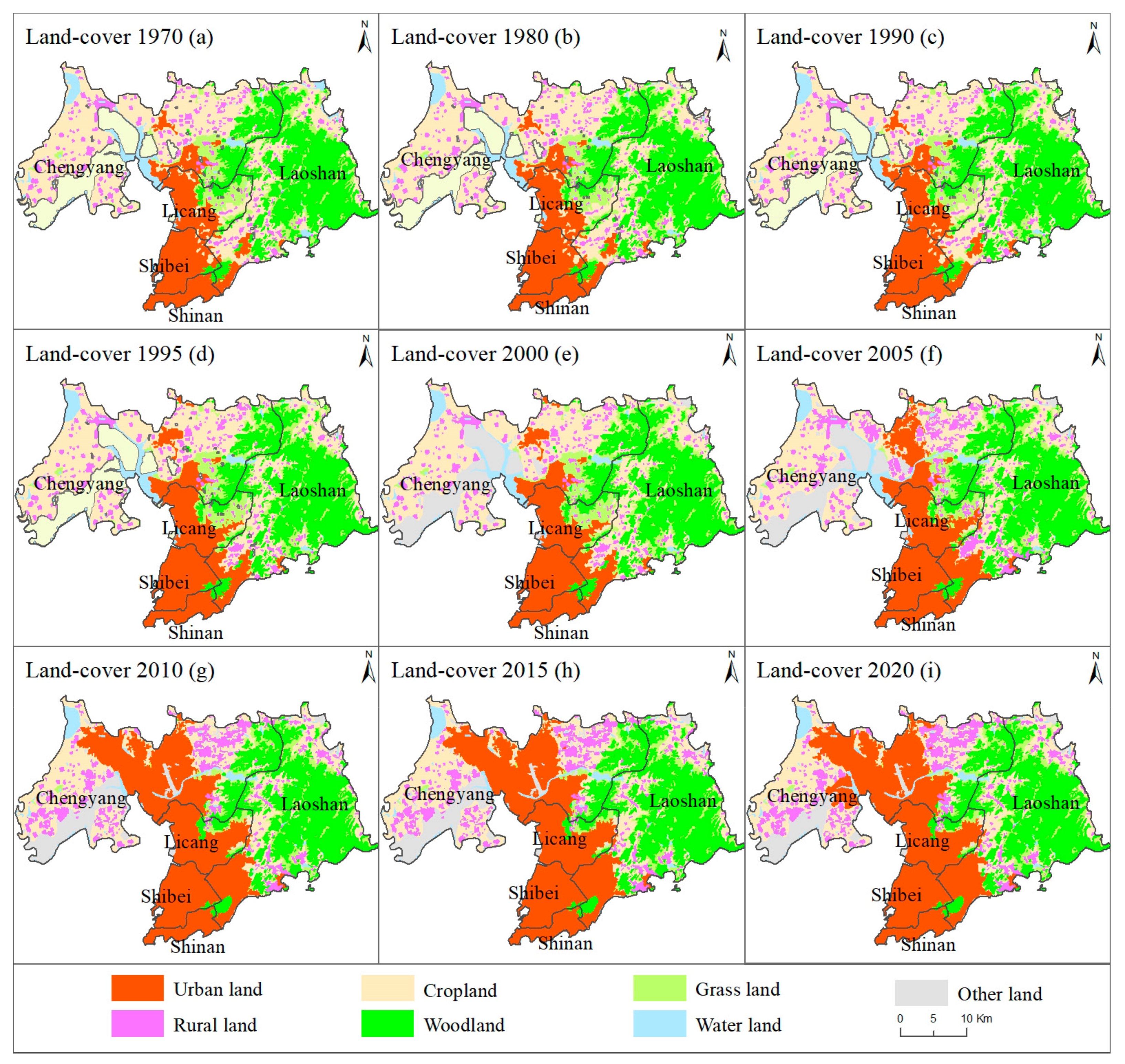
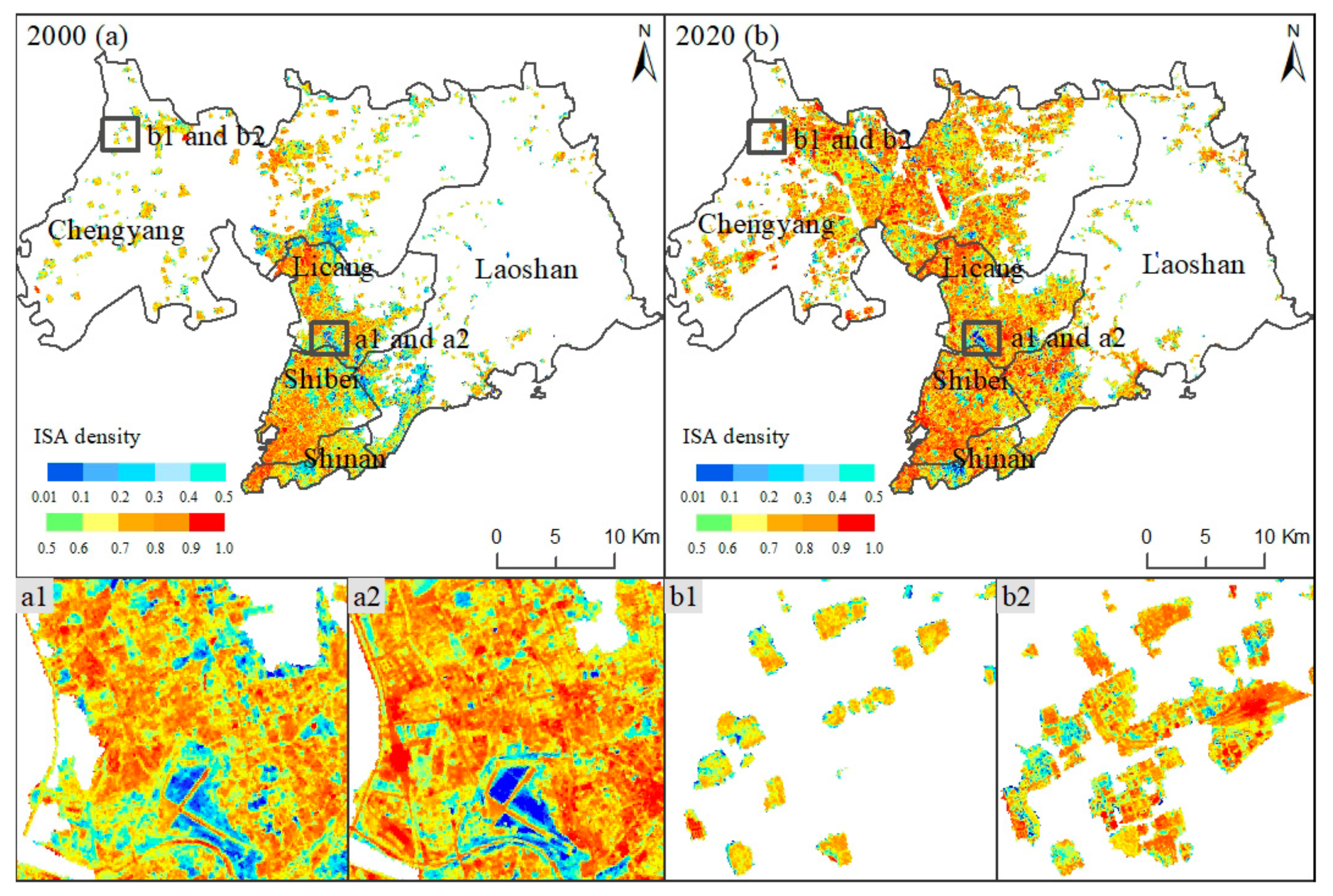
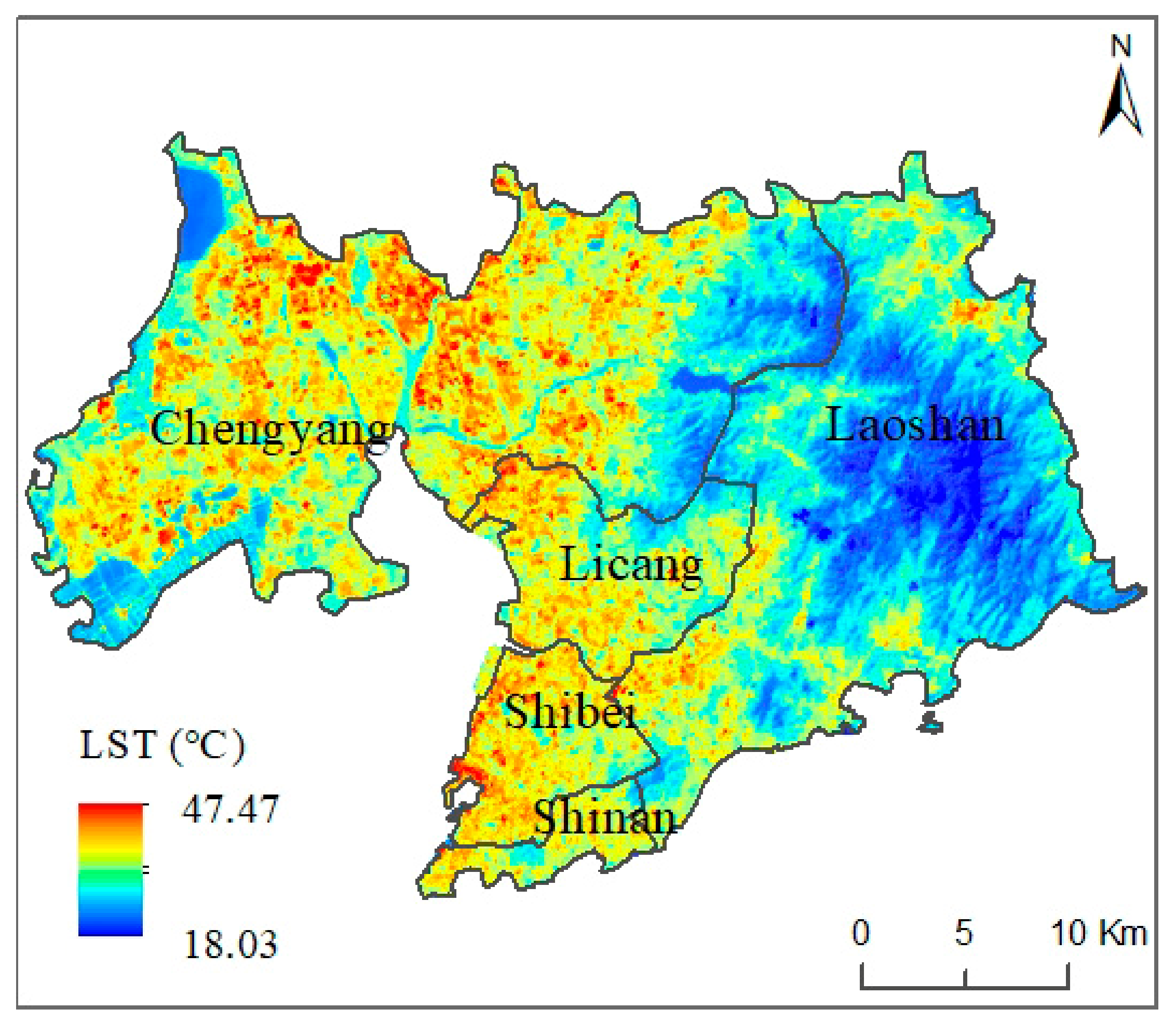
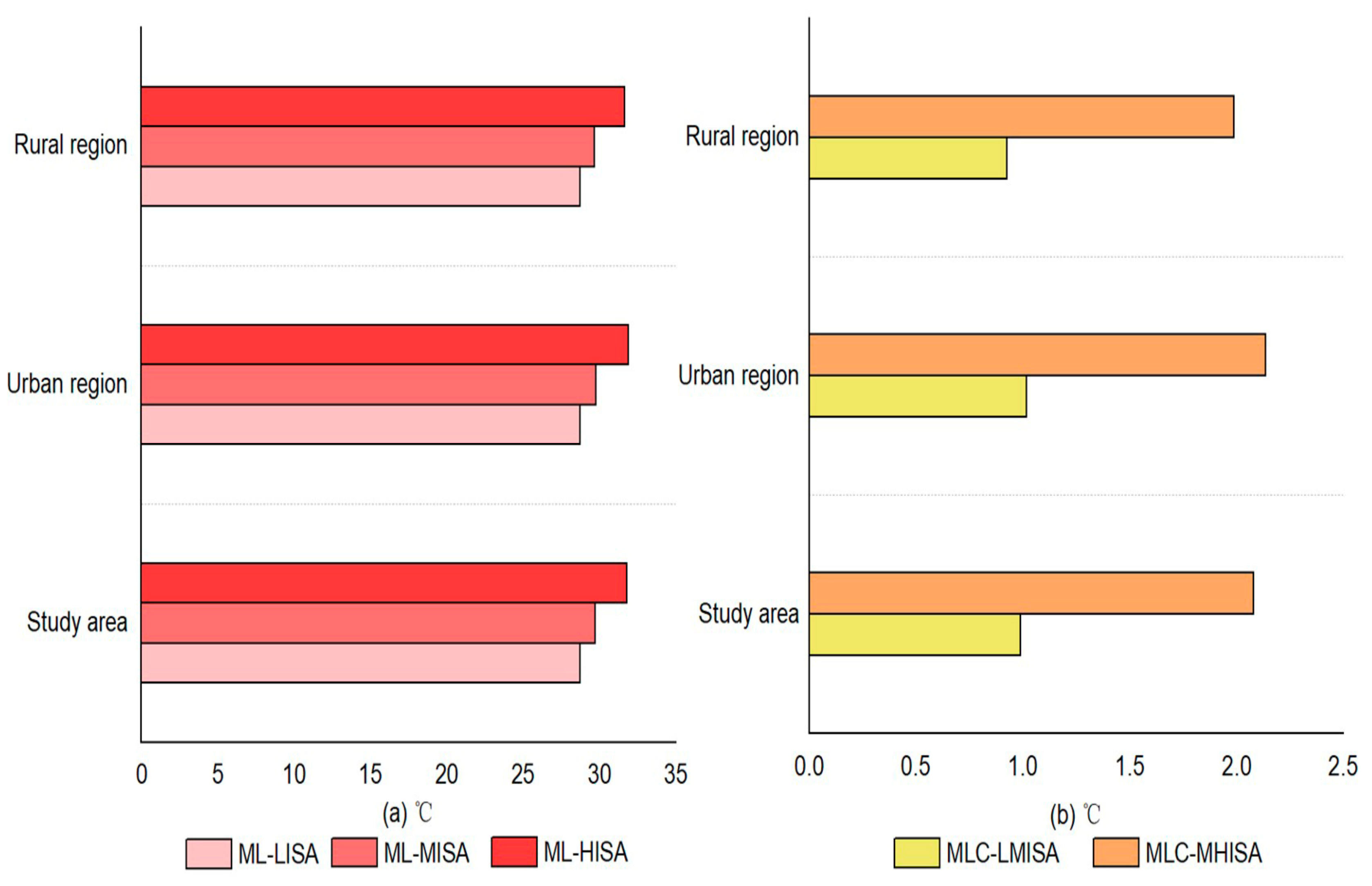
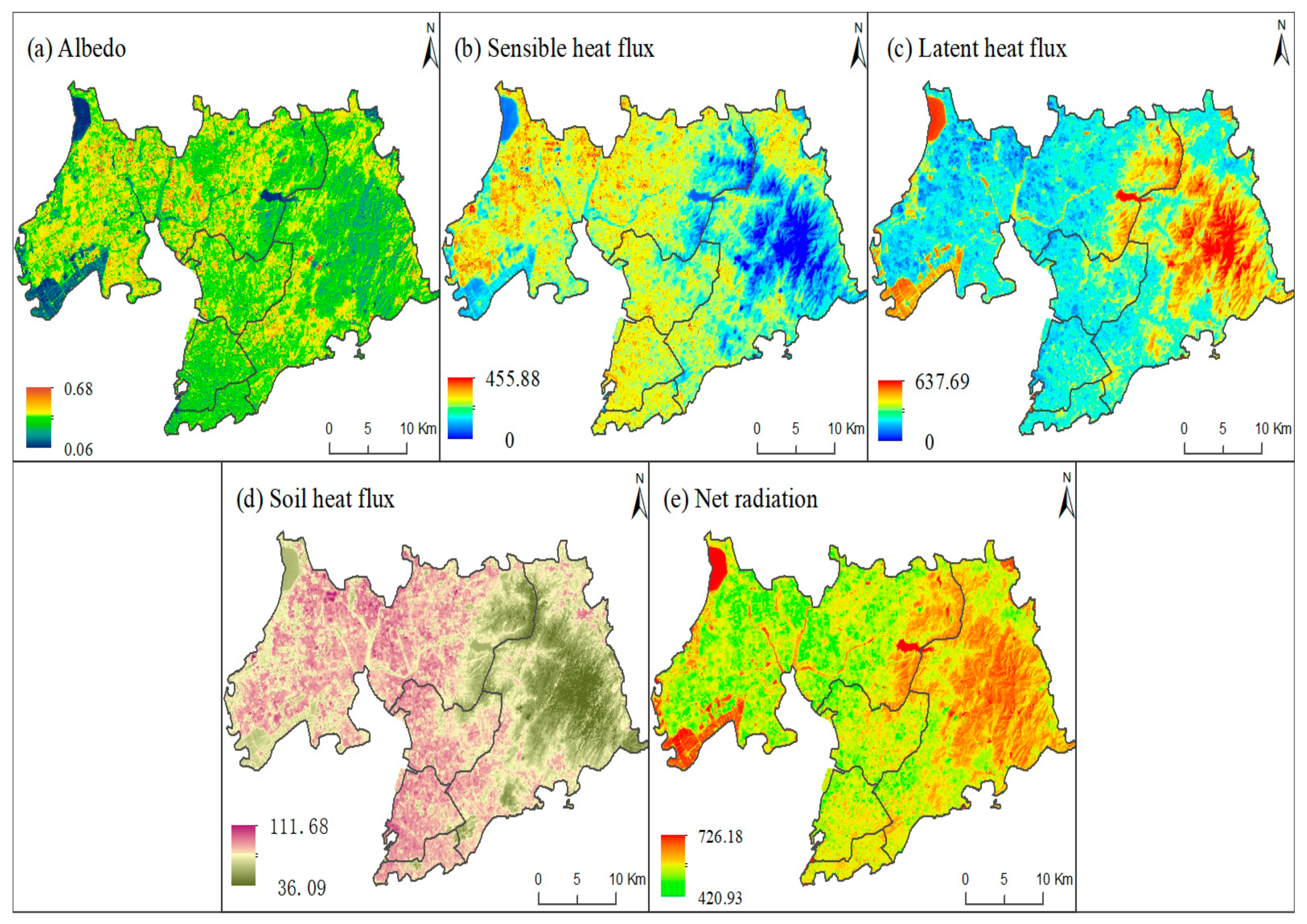
| Year | Index | Unit | Chengyang District | Laoshan District | Licang District | Shibei District | Shinan District | |||
|---|---|---|---|---|---|---|---|---|---|---|
| Urban | Rural | Urban | Rural | Urban | Rural | Urban | Urban | |||
| 1970 | Area | (km2) | 22.80 | 52.09 | 14.56 | 19.18 | 42.24 | 2.75 | 56.16 | 23.14 |
| Ratio | (%) | 4.35 | 9.94 | 3.77 | 4.97 | 45.12 | 2.94 | 89.63 | 82.52 | |
| 1980 | Area | (km2) | 22.93 | 52.30 | 15.68 | 19.21 | 44.39 | 2.78 | 56.51 | 23.98 |
| Ratio | (%) | 4.38 | 9.98 | 4.07 | 4.98 | 47.41 | 2.97 | 90.18 | 85.51 | |
| 1990 | Area | (km2) | 23.81 | 52.64 | 16.14 | 19.43 | 46.51 | 2.79 | 58.08 | 24.32 |
| Ratio | (%) | 4.54 | 10.04 | 4.19 | 5.04 | 49.68 | 2.98 | 92.69 | 86.73 | |
| 1995 | Area | (km2) | 28.67 | 53.53 | 23.14 | 19.46 | 53.31 | 1.93 | 60.02 | 24.76 |
| Ratio | (%) | 5.47 | 10.21 | 6.00 | 5.05 | 56.94 | 2.07 | 95.78 | 88.30 | |
| 2000 | Area | (km2) | 30.66 | 53.59 | 26.8 | 19.5 | 54.01 | 1.8 | 60.47 | 26.98 |
| Ratio | (%) | 5.85 | 10.23 | 6.95 | 5.05 | 57.69 | 1.92 | 96.5 | 96.2 | |
| 2005 | Area | (km2) | 49.69 | 73.18 | 34.67 | 25.76 | 60.76 | 3.18 | 60.47 | 26.99 |
| Ratio | (%) | 9.48 | 13.97 | 8.98 | 6.68 | 64.9 | 3.4 | 96.49 | 96.2 | |
| 2010 | Area | (km2) | 141.92 | 72.15 | 42.97 | 27.23 | 72.67 | 0.97 | 61.18 | 27.02 |
| Ratio | (%) | 27.09 | 13.77 | 11.13 | 7.06 | 77.63 | 1.04 | 97.63 | 96.35 | |
| 2015 | Area | (km2) | 142.55 | 73 | 43.48 | 27.51 | 72.91 | 1.13 | 61.18 | 27.03 |
| Ratio | (%) | 27.21 | 13.94 | 11.27 | 7.13 | 77.88 | 1.21 | 97.63 | 96.36 | |
| 2020 | Area | (km2) | 161.03 | 77.34 | 44.54 | 27.51 | 73.74 | 1.3 | 61.18 | 27.03 |
| Ratio | (%) | 30.74 | 14.76 | 11.54 | 7.13 | 78.77 | 1.39 | 97.63 | 96.36 | |
| Types | Urban Region | Rural Region | ||
|---|---|---|---|---|
| Area (km2) | Ratio (%) | Area (km2) | Ratio (%) | |
| EHTA | 0.7865 | 0.2142 | 0.0727 | 0.0685 |
| HTA | 24.5488 | 6.6868 | 3.9954 | 3.7693 |
| MTA | 338.4178 | 92.1814 | 100.9302 | 95.2168 |
| LTA | 3.3523 | 0.9131 | 1.0013 | 0.9446 |
| ELTA | 0.0162 | 0.0044 | 0.0009 | 0.0008 |
Disclaimer/Publisher’s Note: The statements, opinions and data contained in all publications are solely those of the individual author(s) and contributor(s) and not of MDPI and/or the editor(s). MDPI and/or the editor(s) disclaim responsibility for any injury to people or property resulting from any ideas, methods, instructions or products referred to in the content. |
© 2023 by the authors. Licensee MDPI, Basel, Switzerland. This article is an open access article distributed under the terms and conditions of the Creative Commons Attribution (CC BY) license (https://creativecommons.org/licenses/by/4.0/).
Share and Cite
Pan, T.; Li, B.; Ning, L. Impervious Surface Area Patterns and Their Response to Land Surface Temperature Mechanism in Urban–Rural Regions of Qingdao, China. Remote Sens. 2023, 15, 4265. https://doi.org/10.3390/rs15174265
Pan T, Li B, Ning L. Impervious Surface Area Patterns and Their Response to Land Surface Temperature Mechanism in Urban–Rural Regions of Qingdao, China. Remote Sensing. 2023; 15(17):4265. https://doi.org/10.3390/rs15174265
Chicago/Turabian StylePan, Tao, Baofu Li, and Letian Ning. 2023. "Impervious Surface Area Patterns and Their Response to Land Surface Temperature Mechanism in Urban–Rural Regions of Qingdao, China" Remote Sensing 15, no. 17: 4265. https://doi.org/10.3390/rs15174265
APA StylePan, T., Li, B., & Ning, L. (2023). Impervious Surface Area Patterns and Their Response to Land Surface Temperature Mechanism in Urban–Rural Regions of Qingdao, China. Remote Sensing, 15(17), 4265. https://doi.org/10.3390/rs15174265








